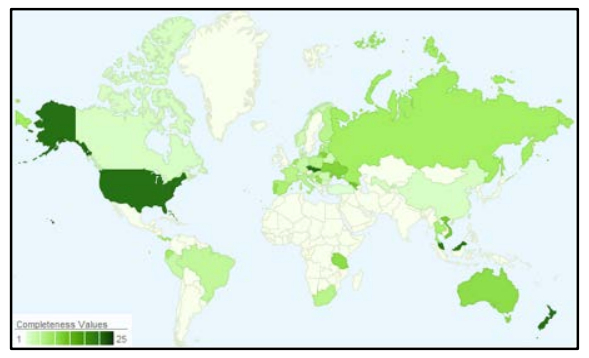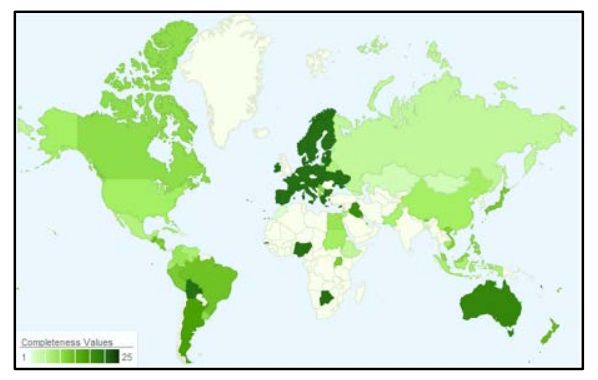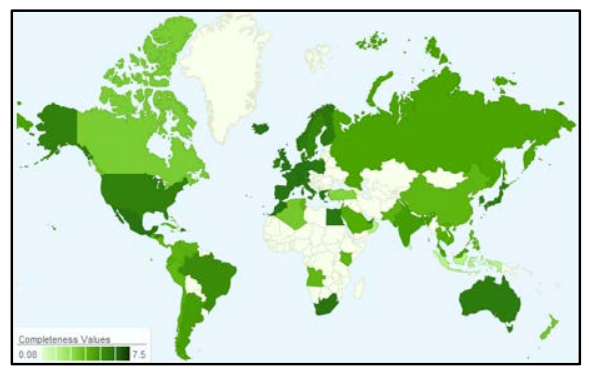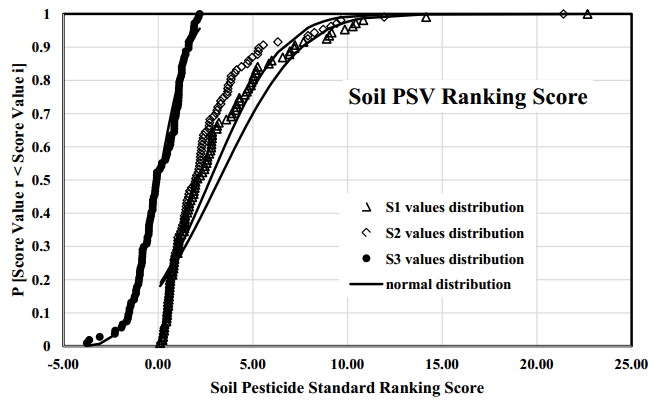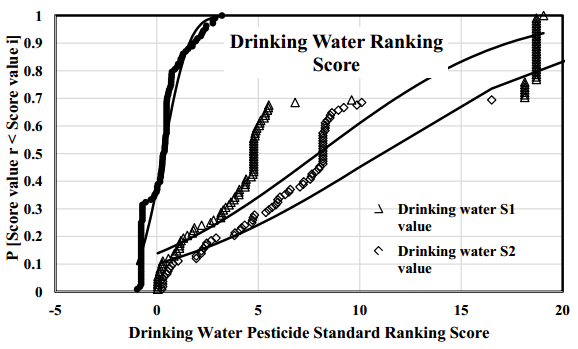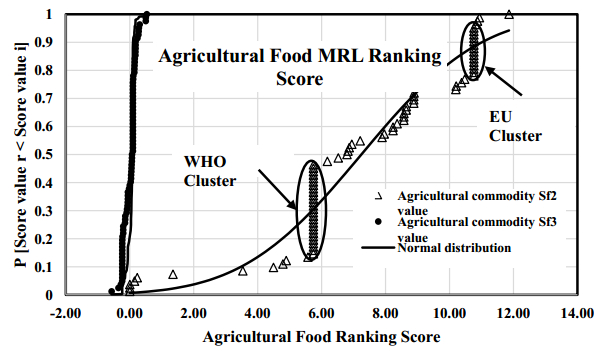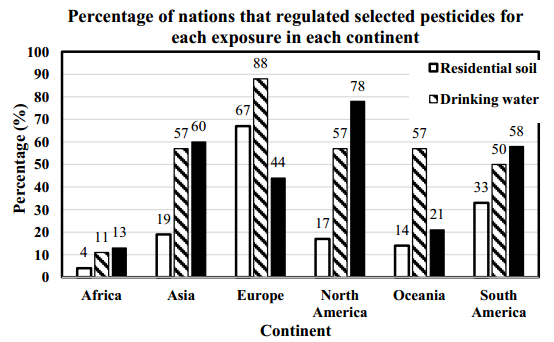1. Introduction
Pesticides are widely applied for pest control around the world and largely used in agricultural, industrial, commercial, home, and garden fields. Like other chemical contaminants, pesticides will be transported to major environmental sinks after application, which includes air, biomass (crops, plants, animals, and other living organisms), soil, and water. The pervasive presence of pesticides in the environment makes pesticides easy to get into the human body by ingestion of pesticide contaminated water, food, and soil, inhalation of pesticides contaminated air and soil dust, and dermal contact with food, water, air, and soil contaminated by pesticides. To control the risk of human exposure to pesticides, worldwide jurisdictions are taking action to regulate PSVs. The PSV in this research means either soil RGV, drinking water MCL, or agricultural commodity MRL. Generally, PSVs should be regulated in all possible exposures and derived based on certain human health risk models to effectively protect human health. Several previous studies[1,2] have examined the variability of drinking water MCLs. Some studies [3,4] were conducted on pesticide food standard analysis. Previous studies indicate that worldwide jurisdictions did not make an agreement on PSVs in residential soil [5,6,7,8,9] and drinking water [10]. Although some nations share same values in regulating pesticide agricultural commodity MRLs, there are still many MRLs too large to effectively protect human health [10]. Most nations did not regulate the pesticide standards in the residential air, probably because when some organochlorine and organophosphate pesticides evaporate into the atmosphere, their half-lives are usually very short, and however, there is still little information about regulating volatile and semi-volatile pesticides standards in the air. Therefore, promulgating PSVs is still a worldwide problem and complex work because for hundreds of currently used pesticides, many of them have over 100,200, or even 300 different standard values in different nations worldwide. Some nations regulated pesticide soil RGVs very conservatively while providing some extremely large pesticide drinking water MCLs as a comparison with other nations. Some nations provided full information soil RGV set but did not regulate pesticide agricultural commodity MRLs. It is necessary to evaluate worldwide jurisdictions performance regarding their PSVs to help jurisdiction makers know how their PSVs perform as a comparison of other jurisdictions. In this research, pesticide national jurisdictions were ranked based on their PSVs performance. Because only U.S. regulated pesticide standards in the air, PSVs analysis for air was omitted in the ranking system. The objective of this study is to rank and compare the worldwide pesticide regulatory jurisdictions by completeness and numerical analysis of the PSVs. Hopefully, the results will benefit worldwide environmental policy makers to review and formulate the PSVs.
2. Materials
2.1. Residential Soil RGVs from National Jurisdictions
A total of 174 worldwide jurisdictions from 50 nations have provided at least 19 421 pesticide RGVs. To build a ranking system for national jurisdictions, a total of 57 national soil pesticide jurisdictions out of 174 were selected in this study (Table 1). The website addresses and dates accessed of those references in Table 1 were listed in the supplementary materials S1, and when websites are out of date or invalid, some keywords of the document titles could be used to conduct the internet search. Most of worldwide national jurisdictions were published as foreign languages and a total of 29 foreign languages were translated into English. USEPA has regulated the most pesticide soil RGVs, about 516 in total. Turkey and one national jurisdiction from U.K. only regulated one pesticide. Belarus (139), Moldova (166), and Uzbekistan (104) regulated the numbers of RGVs, which are similar to Russia (146) probably because they adopted some values from former Union of Soviet Socialist Republics (USSR).
Table 1. National jurisdictions for pesticides residential soil RGVs.
| Jurisdictions |
No. of RGVs |
References for pesticide RGVs |
Language |
| Principality of Andorra |
14 |
Andorra Official Gazette (2010) |
Catalan |
| Republic of Armenia |
286 |
Armenia Minister of Health (2011) |
Armenian |
| Commonwealth of Australia |
48 |
Australia National Environmental Protection Council (ANEPC) (2013) |
English |
| Commonwealth of the Bahamas |
123 |
Bahamas Ministry of Works and Transport (2008) |
English |
| Republic of Belarus |
139 |
Belarus Ministry of Health (2004) |
Belarusian |
| Federative Republic of Brazil |
8 |
Brazil Ministry of the Environment (2009) |
Portuguese |
| Republic of Bulgaria |
64 |
Bulgaria Ministry of Environment and Water (2001,2008) |
English and Bulgarian |
| Canada |
4 |
Canadian Council of Ministers of the Environment (CCME) (2014) |
English |
| People's Republic of China |
20 |
People's Republic of China (PRC) (1995), and PRC Ministry of Environmental Protection (2006) |
Chinese |
| Republic of Costa Rica |
8 |
Costa Rica President of the Republic, Minister of Health, Minister of Environment, Energy and Telecommunications, and Minister of Agriculture and Livestock (2010) |
Spanish |
| (Croatia) Agricultural Univ. of Zagreb |
15 |
Agriculture University of Zagreb (2008) |
Croatian |
| Czech Republic |
11 |
Czech Republic Ministry of Environment (1994), Carlon (2007) |
English |
| Kingdom of Denmark |
9 |
Danish Environmental Protection Agency (2002,2010) |
English and Danish |
| Republic of Ecuador |
27 |
Ecuador Ministry of Environment (2002) |
Spanish |
| Republic of Estonia |
12 |
Estonia Ministry of the Environment (2004) |
Estonian |
| Republic of Finland |
12 |
Finland Ministry of the Environment (2007) |
Finish |
| French Republic |
18 |
Carlon (2007) |
English |
| Georgia |
231 |
Georgia Minister of Health, Labor and Social Affairs (2001), and Georgia Ministry of Environment and Minister of Natural Resources (2006) |
Georgian |
| Federal Republic of Germany |
8 |
German Federal Ministry of the Environment, Nature Conservation and Nuclear Safety (1999). |
German |
| Hungary |
68 |
Hungary Ministry of the Environment, Ministry of Environment, Ministry of Health, Ministry of Agriculture, and Ministry of Transport (2000) |
Hungarian |
| Republic of Italy |
13 |
President of the Republic of Italy (2006) |
Italian |
| Republic of Latvia |
17 |
Latvia Cabinet of Ministers (2005) |
Latvian |
| Republic of Lithuania |
24 |
Lithuania Minister of Environment (2008) |
Lithuanian |
| Malaysia |
194 |
Malaysia Dept. of Environment (2009) |
English |
| Republic of Moldova |
166 |
Moldova Ministry of Ecology and Natural Resources (2004) |
Romanian |
| Montenegro |
9 |
Official Gazette of Montenegro (1997) |
Croatian |
| Kingdom of the Netherlands |
61 |
Netherlands National Institute for Public Health and Environment (2001,2006,2009) |
English and Dutch |
| New Zealand |
344 |
New Zealand Ministry of the Environment (1997,2006,2011,2012,2013) |
English |
| Kingdom of Norway |
3 |
Norwegian Pollution Control Authority (1999) |
English |
| Republic of Panama |
20 |
Panama Ministry of Economy and Finance (2009) |
Spanish |
| Republic of Peru |
4 |
Peru Ministry of Environment (2013) |
Spanish |
| Republic of Poland |
14 |
Poland Minister of the Environment (2002) |
Polish |
| Republic of Portugal |
15 |
Portuguese Environment Agency (2012), and Ontario Ministry of Environment and Energy (1997) |
Portuguese and English |
| State of Qatar |
4 |
Qatar Ministry of Environment (2013), CCME (2007) |
Arabic and English |
| Romania |
56 |
Romanian Ministry of Water, Forests, and Environmental Protection (1997) |
Romanian |
| Russian Federation |
146 |
Russian Ministry of Environment and Natural Resources (1993), Russian State Construction Code (1997) |
Russian |
| Republic of Serbia |
56 |
Serbia Agency for Environmental Protection (2010) |
Serbian |
| Republic of Singapore |
46 |
Singapore National Environmental Agency (2010) |
English |
| Slovak Republic |
5 |
Slovakia Ministry of Agriculture (2004) |
Slovak |
| Republic of Slovenia |
45 |
Slovenia Ministry of Environment and Spatial Planning (1996) |
Slovenian |
| Republic of South Africa |
10 |
South Africa Minister of Water and Environmental Affairs (2008) |
English |
| Kingdom of Spain |
14 |
Office of the President of the Government of Spain (OPGS) (2005) |
Spanish |
| United Republic of Tanzania |
17 |
Tanzania National Environmental Management Council (2007) |
English |
| Kingdom of Thailand |
9 |
Thailand Ministry of Natural Resources and Environment (2004) |
English |
| Republic of Turkey |
1 |
Turkey Ministry of Environment and Forestry (2001) |
Turkish |
| Ukraine |
286 |
Ukraine Ministry of Health (2001) |
Ukrainian |
| (United Kingdom) Anglian Water Services, Ltd. |
1 |
Anglian Water Services Ltd. (2010) |
English |
| (United Kingdom) White, Young, Green Environmental, Ltd. |
2 |
White Young Green Environmental Ltd. (2008) |
English |
| (United Kingdom) Environmental Industries Commission |
36 |
Environmental Industries Commission, The Association of Geotechnical and Geo-environmental Specialists, and Contaminated Land: Applications in Real Environments (2010) |
English |
| U.S. Environmental Protection Agency |
516 |
U.S. Environmental Protection Agency (USEPA) (2013) |
English |
| U.S. Army |
259 |
U.S. Army Center for Health Promotion and Preventive Medicine (2013) |
English |
| (U.S.) National Oceanic and Atmospheric Administration |
39 |
National Oceanic and Atmospheric Administration Office of Response and Restoration (2008) |
English |
| (U.S.) National Aeronautics and Space Administration |
20 |
Boeing Company, National Aeronautics and Space Administration, and Dept. of Energy (2010) |
English |
| (U.S.) Department of Energy |
20 |
Boeing Company, National Aeronautics and Space Administration, and Dept. of Energy (2010) |
English |
| (U.S.) Agency for Toxic Substances and Disease Registry |
26 |
Agency for Toxic Substances and Disease Registry (2014) |
English |
| Republic of Uzbekistan |
104 |
Head State Health Officer of the Republic of Uzbekistan (2005) |
Russian |
| Socialist Republic of Vietnam |
60 |
Republic of Vietnam (1995,2008) |
Vietnamese |
2.2. Drinking Water MCLs from National Jurisdictions
A total of 5474 pesticides drinking water MCLs from 104 nations were identified (Table 2). The website addresses and dates accessed of those references in Table 2 were listed in the supplementary materials S2. Thirty-four foreign languages for international documents were translated into English. Australia provided 152 MCLs which is the largest set among those national jurisdictions. Some nations such as Albania, Antigua and Barbuda, Bahamas, and Fiji got 36 MCLs because they adopted the WHO standards. The European Union (EU) and several nations promulgated MCLs for distinct classes of pesticides but the total number of MCLs is unknown because the members of these classes are not specified individually.
Table 2. National jurisdictions for pesticides drinking water MCLs.
| Jurisdictions |
No. of MCLs |
References of pesticide MCLs |
Language |
| Republic of Albania |
36 |
Albania Institute for European Environmental Policy (2007) |
Albanian |
| Principality of Andorra |
25 |
Andorra Official Gazette (1999) |
Catalan |
| Antigua and Barbuda |
36 |
Environmental Solutions Antigua Limited (2008) |
English |
| Argentine Republic |
49 |
Argentine Official Gazette (1993) |
Spanish |
| Commonwealth of Australia |
152 |
National Health and Medical Research Council (2013) |
English |
| Republic of Austria |
UNK* |
Austria Dept. of Health (2013) |
German |
| Commonwealth of the Bahamas |
36 |
The Bahamas Water and Sewerage Corporation (1999) |
English |
| People's Republic of Bangladesh |
2 |
Amio Water Treatment Limited (2010) |
English |
| Republic of Belarus |
16 |
Belarus Ministry of Health (2013) |
Russian |
| Kingdom of Belgium |
|
Brussels-Capital Region Government (2014) |
English |
| Belize |
36 |
Belize Agricultural Health Authority (2003) |
English |
| Kingdom of Bhutan |
36 |
Codex Alimentarius (2001) |
English |
| Plurinational State of Bolivia |
UNK* |
Bolivia Ministry of Public Works and Services Vice of Basic Services (2004) |
Spanish |
| Republic of Botswana |
UNK* |
Water Utilities Corporation (2000) |
English |
| Federative Republic of Brazil |
26 |
Brazil Ministry of Health (2004) |
Portuguese |
| Republic of Bulgaria |
UNK* |
Bulgaria Ministry of Health (2001) |
Bulgarian |
| Kingdom of Cambodia |
19 |
Cambodia Ministry of Industry Mines and Energy (2004) |
English |
| Canada |
25 |
Health Canada (2012) |
English |
| Republic of Chile |
8 |
Chile Ministry of Public Works (2005) |
Spanish |
| People's Republic of China |
17 |
China Dept. of Health (2007) |
Chinese |
| Republic of Colombia |
16 |
Colombian Institute for Technical Standards and Certification (1994) |
Spanish |
| Republic of Costa Rica |
33 |
Costa Rica Minister of Finance (2005) |
Spanish |
| Republic of Croatia |
UNK* |
Croatia Ministry of Health and Social Welfare (2007) |
Croatian |
| Republic of Cuba |
16 |
Cuba Government (1997) |
Spanish |
| Republic of Cyprus |
UNK* |
Cyprus Ministry of Agriculture, Natural Resources and Environment (1999) |
English |
| Czech Republic |
UNK* |
European Commission (1998) |
Czech |
| Kingdom of Denmark |
UNK* |
Nature Agency of Denmark (2014) |
Danish |
| Dominican Republic |
UNK* |
Dominican Ministry of Public Health and Social Assistance (2005) |
Spanish |
| Republic of Ecuador |
19 |
Ecuadorian Institute of Standards (2011) |
Spanish |
| Arab Republic of Egypt |
33 |
World Health Organization Regional Office for the Eastern Mediterranean (2006) |
English |
| Republic of Estonia |
UNK* |
Estonia Minister of Social Affairs (2013) |
Estonian |
| Federal Democratic Republic of Ethiopia |
10 |
World Health Organization (2010) |
English |
| Republic of Fiji |
36 |
Secretariat of the Pacific Community (2005) |
English |
| Republic of Finland |
UNK* |
Finland Minister of Social Affairs and Health (2001) |
Finish |
| French Republic |
UNK* |
France Ministry of Ecology, Sustainable Development And Energy (1998) |
French |
| Republic of the Gambia |
UNK* |
Gambia Environmental Quality Standards Board (1999) |
English |
| Georgia |
UNK* |
Georgia Ministry of Justice (2007) |
Georgian |
| Federal Republic of Germany |
UNK* |
Germany Federal Ministry of Justice and Consumer Protection (2001) |
German |
| Hellenic Republic |
UNK* |
Greece Central Public Health Laboratory (1998) |
Greek |
| Republic of Guatemala |
55 |
Guatemala Government (1999) |
Spanish |
| Republic of Honduras |
33 |
Honduras Dept. of Health (1995) |
Spanish |
| Republic of Hungary |
UNK* |
Hungary National Public Health and Medical Officer Service (2001) |
Hungarian |
| Republic of Indonesia |
17 |
Indonesia Government (1990) |
Indonesian |
| Republic of Iraq |
3 |
Iraq Central Agency for Meteorology and Quality Control (2001) |
Arabic and English |
| Ireland |
UNK* |
Ireland EPA (2007) |
English |
| State of Israel |
7 |
Israel Ministry of Health (2000) |
Hebrew |
| Republic of Italy |
59 |
Navy Medicine (2012) |
English |
| Japan |
36 |
Japan Ministry of Health, Labor and Welfare (2001) |
English and Japanese |
| Hashemite Kingdom of Jordan |
11 |
The Jordanian Institute of Standards and Metrology (2001) |
English |
| Republic of Kazakhstan |
3 |
Kazakhstan Government (2001) |
Russian |
| Republic of Kiribati |
36 |
Secretariat of the Pacific Community (2005) |
English |
| Republic of Korea |
5 |
Korea Ministry of Environment (2011) |
English |
| State of Kuwait |
36 |
World Health Organization Regional Office for the Eastern Mediterranean (2006) |
English |
| Republic of Latvia |
UNK* |
Latvia Ministry of Health (2004) |
Latvian |
| Lebanese Republic |
4 |
World Health Organization Regional Office for the Eastern Mediterranean (2006) |
English |
| Principality of Liechtenstein |
UNK* |
Liechtenstein Drinking Water Inspectorate (1999) |
English |
| Republic of Lithuania |
UNK* |
Lithuania Ministry of Health (2003) |
Lithuanian |
| Grand Duchy of Luxembourg |
UNK* |
Luxembourg Collection of Legislation (2002) |
French |
| Malaysia |
23 |
Malaysia Ministry of Health (2010) |
English |
| Republic of Malta |
UNK* |
Malta Government (2009) |
Maltese |
| Republic of Mauritius |
10 |
Mauritius Government Gazette (1996) |
English |
| United Mexican States |
18 |
Government of Mexico (1994) |
Spanish |
| Mongolia |
5 |
Government of Mongolia (2005) |
Mongolian |
| Kingdom of Morocco |
1 |
World Health Organization Regional Office for the Eastern Mediterranean (2006) |
English |
| Republic of Nauru |
36 |
Secretariat of the Pacific Community (2005) |
English |
| Kingdom of the Netherlands |
UNK* |
Government of Netherlands (2014) |
Dutch |
| New Zealand |
55 |
New Zealand Ministry of Health (2008) |
English |
| Republic of Nicaragua |
35 |
Nicaragua Ministry of Health (1994) |
Spanish |
| Federal Republic of Nigeria |
UNK* |
Standards Organization of Nigeria (2007) |
English |
| Kingdom of Norway |
UNK* |
Norway Ministry of Health and Care Services (2001) |
Norwegian |
| Islamic Republic of Pakistan |
19 |
Pakistan Standards and Quality Control Authority (Undated) |
English |
| Republic of Palau |
6 |
Environmental Quality Protection Board (Undated) |
English |
| Republic of Peru |
45 |
Peru Ministry of Health (2011) |
Spanish |
| Republic of the Philippines |
17 |
Philippines Dept. of Health (2007) |
English |
| Republic of Poland |
UNK* |
Poland Ministry of Health (2007) |
Polish |
| Portuguese Republic |
UNK* |
Portugal Ministry of Environment, Planning and Regional Development (2007) |
Portuguese |
| State of Qatar |
33 |
The Gulf Cooperation Council (GCC) Standardization (2012) |
Arabic and English |
| Russian Federation |
106 |
Russian Ministry of Health (1998,1999,2002,2007) |
Russian |
| Republic of Rwanda |
19 |
Rwanda Standards Board (2013) |
English |
| Saint Lucia |
40 |
Caricom Regional Organization for Standards and Quality (undated) |
English |
| Republic of Serbia |
28 |
Serbia Official Gazette (1999) |
English |
| Republic of Singapore |
39 |
Government of Singapore (2008) |
English |
| Slovak Republic |
UNK* |
Council Regulation Government of the Slovak Republic (2010) |
Slovak |
| Republic of Slovenia |
UNK* |
Slovenia Ministry of Health (2004) |
Slovenian |
| Republic of South Africa |
1 |
South Africa Dept. of Water and Sanitation (2005) |
English |
| Kingdom of Spain |
UNK* |
Government of Spain (2003) |
Spanish |
| Republic of the Sudan |
36 |
World Health Organization Regional Office for the Eastern Mediterranean (2006) |
English |
| Kingdom of Sweden |
UNK* |
Sweden Nutrition and Food Agency (2001) |
Swedish |
| Swiss Confederation |
UNK* |
Switzerland Dept. of Consumer and Veterinary (2014) |
French |
| Syrian Arab Republic |
12 |
World Health Organization Regional Office for the Eastern Mediterranean (2006) |
English |
| United Republic of Tanzania |
1 |
Tanzania Bureau of Standards (2009) |
English |
| Kingdom of Thailand |
1 |
Thailand Ministry of Health (2001) |
Thai |
| Kingdom of Tonga |
36 |
Secretariat of the Pacific Community (2005) |
English |
| Republic of Tunisia |
1 |
Global Water and Wastewater Quality Regulations (2012) |
English |
| Tuvalu |
36 |
Secretariat of the Pacific Community (2005) |
English |
| Republic of Uganda |
34 |
Uganda Ministry of Tourism, Trade and Industry (2008) |
English |
| Ukraine |
UNK* |
Ukraine Water Health (Undated) |
Russian |
| United Kingdom of Great Britain and Northern Ireland |
UNK* |
United Kingdom Drinking Water Inspectorate (2000) |
English |
| United States of America |
24 |
U.S. Environmental Protection Agency (2009) |
English |
| Eastern Republic of Uruguay |
41 |
Uruguay Administration of Sanitary Works (2006) |
Spanish |
| Republic of Uzbekistan |
2 |
Uzbekistan Ministry of Health (2006) |
Russian |
| Republic of Vanuatu |
36 |
Secretariat of the Pacific Community (2005) |
English |
| Bolivarian Republic of Venezuela |
16 |
Venezuela Ministry of Health And Welfare (1998) |
Spanish |
| Socialist Republic of Viet Nam |
36 |
Viet Nam Ministry of Health (2002) |
Vietnamese |
| * UNK—The European Union and several nations promulgate MCLs for distinct classes of pesticides but since the members of these classes are not specified individually, the total number of MCLs is unknown. |
2.3. Agricultural Commodity MRLs from National Jurisdictions
The Global MRL Database [11] collected agricultural commodity pesticide MRLs from nearly 90 worldwide jurisdictions (Table 3). Each nation only got one national jurisdiction on MRLs because of the international trade need. In this research, the commonly consumed agricultural commodities were selected in the analysis based on human diet statistical data.
Table 3. National jurisdictions for pesticides agricultural MRLs.
| Worldwide jurisdictions |
| United States |
Codex (WHO) |
European Union |
Albania |
Algeria |
| Angola |
Antigua/Barbuda |
Argentina |
Australia |
Bahamas |
| Bahrain |
Bangladesh |
Barbados |
Belgium |
Bermuda |
| Brazil |
Brunei |
Cambodia |
Canada |
Cayman Islands |
| Chile |
China |
Colombia |
Costa Rica |
Cuba |
| Customs Union |
Denmark |
Dominica |
Ecuador |
Egypt |
| El Salvador |
Finland |
France |
French Polynesia |
West Indies |
| Germany |
Greece |
Guatemala |
Gulf Cooperation |
Haiti |
| Honduras |
Hong Kong |
Iceland |
India |
Indonesia |
| Ireland |
Israel |
Italy |
Jamaica |
Japan |
| Jordan |
Kenya |
Korea |
Kuwait |
Lebanon |
| Malaysia |
Mexico |
Morocco |
Netherlands |
Antilles |
| New Zealand |
Nicaragua |
Norway |
Oman |
Pakistan |
| Panama |
Peru |
Philippines |
Poland |
Portugal |
| Qatar |
Russia |
Saudi Arabia |
Singapore |
South Africa |
| Spain |
Sri Lanka |
St. Lucia |
Sweden |
Switzerland |
| Taiwan |
Thailand |
Trinidad/Tobago |
Tunisia |
Turkey |
| UAE |
United Kingdom |
Venezuela |
Vietnam |
|
3. Methods
3.1. Selected Pesticides for Ranking System
There are hundreds of pesticides regulated in the soil, drinking water, and agricultural commodities. In this research, 25 important pesticides were selected for the ranking system. The 25 pesticides were selected due to current and historical largely usage. Because large amounts of these pesticides were applied and most of them were transported to the soil, air, water, and biomass, the selected pesticides become important factors to build the ranking system.
3.2. Pesticide Completeness Score Values
Since little information was found about the pesticide air standards, national jurisdictions ranking systems were developed only for soil, drinking water, and agricultural commodity exposures. Pesticide completeness score value was introduced to examine the degree to which regulated standard values by national jurisdictions are enough for those selected pesticides in major exposure. The completeness score was computed based on the PSVs number of 25 selected pesticides for soil (Cs), drinking water (Cw), and food (Cf). Each completeness score has the maximum value of 25 and completeness score for air was omitted due to lack of information. If a nation got larger completeness score value that country regulated more PSVs for those 25 selected pesticides.
|
Cs=25∑i=1xi;∀xi=(1,ifthereisapesticidesoilRGV;0,ifnot)
|
(1)
|
|
Cw=25∑i=1xi;∀xi=(1,ifthereisapesticidedrinkingwaterMCL;0,ifnot)
|
(2)
|
|
Cf=25∑j=1112(12∑i=1xij);∀xi=(1,ifthereisapesticidefoodMRL;0,ifnot)
|
(3)
|
3.3. Pesticide Numerical Standard Score Value
Based on the PSVs magnitude three methods were developed for this national jurisdictions ranking system. These three methods were characterized as Method 1, 2 and 3. The ranking score values yielded from these methods were characterized as S1, S2 and S3. Each numerical standard score value has the maximum value of 25.
Method 1 was based on the log-normal random distributions of PSVs. S1 score was developed by summing the probabilities of a random PSV being greater than the jurisdiction's PSV as follows. If a nation has larger S1, it means this country provided a relatively conservative PSV set.
Method 1:
|
S1=25∑i=1{1.0−Normdist[PSVLi−μLiσLi]}
|
(4)
|
The Normdist is the function that calculate the probability of a random Log10 (PSV) being less than that of a Log10 (PSVi).
Method 2 quantified the relative location of the PSV based on the interpolation between the extreme distribution PSVs. If a nation has larger S2, it means this nation provided a relatively conservative PSV set.
Method 2:
|
S2=25∑i=1{1.0−log10(PSVi)−Mini[log10(PSVi)]Maxi[log10(PSVi)]−Mini[log10(PSVi)]}
|
(5)
|
Where Mini[log10 (PSVi)] and Maxi[log10 (PSVi)] are the extreme PSVs in the distribution.
Method 3 was based on the measurement of how close the average PSV is to the central tendency of PSVs distribution. An assumption was made that values about the PSV distribution central tendency fall into a range of credible values around which worldwide consensus may be emerging. S3 score value will be negative if the PSVs from a jurisdiction were below the average value of worldwide PSVs. If a country has a smaller S3, it means this country provided a relatively conservative PSV set.
Method 3:
|
S3=N∑i=1{[log10(PSVi)−μLiN]}
|
(6)
|
Method 1, 2 and 3 were applied to drinking water MCLs and residential soil RGVs. Only method 2 and 3 were used to agricultural commodity MRLs because MRLs distributions were skewed by large data clusters and do not fit the normal random variable model. Method 2 and 3 for agricultural commodity were modified as follows.
Method 2 (food):
|
Sf2=N∑j=1M∑i=1{1.0−log10(MRLij)−Minij[log10(MRL)]Maxij[log10(MRL)]−Minij[log10(MRL)]}
|
(7)
|
Method 3 (food):
|
Sf3=N∑j=11NM∑i=1{[log10(MRLij)−μLijM]}
|
(8)
|
Where M and N are the number of agricultural commodities and pesticides for which a jurisdiction provided the MRLs.
4. Results
4.1. Twenty-five Selected Pesticides
A total of 25 pesticides were selected to build this ranking system based on current and historical largely usage. Current largely used pesticides were selected by the investigation of some worldwide nations which have relatively large populations and high agricultural productivities, such as Australia [12], Brazil [13], Canada [14], China [15], India [16], Philippine [17], Germany [18], Mexico [19], New Zealand [20], South Africa [21], United Kingdom [22] and U.S. [23]. Those pesticides include Glyphosate, Mancozeb, Chlorothalonil, 2, 4-D, Chlorpyriphos, Atrazine, MCPA, Dicamba, Metolachlor, Aldicarb, Malathion, Diazinon, Trifluralin and Diuron. Historical largely used pesticides (the Stockholm Convention Persistent Organic Pollutants) which are banned in most nations include Aldrin, Chlordane, DDT, Dieldrin, Endrin, Heptachlor, Toxaphene, Lindane, Endosulfan, Pentachlorophenol, and Bromomethane. Large amounts of these pesticides applied currently or in the past could result in the ubiquitous presence of these pesticides in soil, water, air and agricultural commodities. So choosing these 25 selected pesticides in this ranking system is a better evaluation of each national jurisdiction.
4.2. National Jurisdictions Rank by Completeness Score
4.2.1. Soil Completeness Score Value Cs
Figure 1 shows the pesticide soil Cs geographic distribution. The darker color the country has a higher Cs, which means this country regulated more selected pesticides in soil. A total of 107 Cs values from 52 nations and territories provided soil RGVs for at least one of the 25 selected pesticides. The Czech Republic, New Zealand, Slovakia and the U.S. provided soil RGVs for all of these selected pesticides. Malaysia provided RGVs for 24 of the pesticides. Turkey and U.K. only provided RGVs for one of these pesticides. Some nations got more than one jurisdiction on pesticide soil RGVs, and only the highest Cs value for that nation will be illustrated in Figure 1. The arithmetic mean and median of Cs are 6.63 and 5.00 respectively, which suggests that most jurisdictions lack pesticide soil RGVs for 25 selected pesticides.
4.2.2. Drinking Water Completeness Score Value Cw
Figure 2 shows the pesticide drinking water Cw geographic distribution. The darker color the country has a higher Cw, which means this country regulated more selected pesticides in drinking water. A total of 108 Cw from 100 nations and territories provided drinking water MCLs for at least one of the 25 selected pesticides. A total of 37 jurisdictions which adopted EU standards provided drinking water MCLs for all of these selected pesticides. Australia regulated 22 and Iraq provided 21 of these selected pesticides. Turkey and U.K. only provided MCLs for one of these pesticides. Some nations got more than one jurisdiction on pesticide drinking water MCLs, and only the highest Cw value for that nation will be illustrated in Figure 2. The arithmetic mean and median of Cw are 14.80 and 13.00 respectively, which suggests that most jurisdictions lack pesticide drinking water MCLs for 25 selected pesticides.
4.2.3. Agricultural Commodity Completeness Score Value Cf
Figure 3 shows the pesticide agricultural commodity Cf geographic distribution. The darker color the country has a higher Cf, which means this country regulated more selected pesticides in agricultural commodities. A total of 90 Cf from 100 nations and territories provided agricultural commodity MRLs for at least one of the 25 selected pesticides. Dominican Republic and Switzerland got the highest Cf value which is 7.5. All of the nations did not regulate the historical largely used pesticides in agricultural commodity probably because they got banned in most nations. However, since those pesticides were environmental persistent and ubiquitous presence it is necessary for nations to provide MRLs for these pesticides in order to protect human health. The arithmetic mean and median of Cf are 5.06 and 4.83 respectively, which suggests that most jurisdictions lack pesticide agricultural commodity MRLs for these 25 selected pesticides.
4.3. National Jurisdictions Rank by Numerical Standard Score Values
4.3.1. Soil Pesticide Score Values
Soil pesticide ranking score S1 calculated by method 1 range from 0.1 to 22.68. The Czech Republic got 22.68 score value and ranked top among those 108 national drinking water jurisdiction score values. The U.S. has eight different S1 values and the USEPA (HQ = 0.1) got the highest S1 among those U.S. jurisdictions which is 10.28. The soil ranking score S2 developed by method 2 range from 0.13 to 21.40. Czech Republic ranks top among those soil national jurisdictions and got 21.40 score value. Again USEPA (HQ = 0.1) ranks top among eight U.S. S2 values with 7.91 score value. For soil ranking score S3 computed by method 3, the values range from −3.76 to 2.69. The Singapore (Target Value) score value is −3.76 which is the lowest, indicating that soil RGVs from Singapore are well below the average. U.S. Department of Energy (DOE) got −1.88 score value which is the lowest among U.S. jurisdictions. Because soil S3 score values were based on the measurement of how close the average PSV is to the central tendency of PSVs distribution. The limitation of S3 is that it did not take account the total number of RGVs regulated for these selected pesticides. The soil RGVs for the 25 selected pesticides were listed in the supplementary material S3.
Figure 4 illustrates soil ranking score S1, S2 and S3 values plotted as cumulative distribution function (CDF) and compared with the CDF of a normal random variable with identical μ and σ statistics. Pearson correlation coefficients of these score values (Table 4) indicates S1, S2 and S3 values are well dispersed over the value span. Although New Zealand got the minimum S1, S2 values, and the maximum S3 values, it has more than one jurisdictions that regulated soil RGVs for these selected pesticides. For example, New Zealand (2006) jurisdiction got 5.00 S1 value which is above the average. The mean and median of these score values indicate that many jurisdictions did not provide enough RGVs for these selected pesticides or the RGVs are relatively high.
Table 4. Statistic summary of pesticide soil ranking score values.
|
Mean |
Median |
Max, nation |
Min, nation |
Pearson correlation coefficient |
| Soil S1 |
3.22 |
2.08 |
22.68, Czech Republic |
0.10, New Zealand |
0.950 |
| Soil S2 |
2.74 |
1.99 |
21.40, Czech Republic |
0.13, New Zealand |
0.943 |
| Soil S3 |
0.03 |
−0.07 |
−3.76, Singapore |
2.19, New Zealand |
0.993 |
4.3.2. Drinking Water Pesticide Score Values
Drinking water pesticide ranking score S1 calculated by method 1 range from 0.04 to 19.06. The Gambia got 19.06 score value and ranks top among those 107 national soil jurisdictions. 25 score values were 18.06 and those jurisdictions adopted the EU standards. The U.S. got 2.80 which is below the average. The drinking water pesticide ranking score S2 developed by method 2 range from 0.25 to 23.79. Also, Gambia jurisdiction ranks top among those drinking water national jurisdictions. The 25 score values were 23.46 and came from jurisdictions that adopted EU standards. The U.S. got 2.81 S2 value which is below the average. Drinking water ranking score S3 was computed by method 3 and the values range from −0.97 to 3.21. The Belarus score value is −0.97 which is the lowest, indicating that drinking water MCLs from Belarus are well below the average because S3 score values were based on the measurement of how close the average PSV is to the central tendency of PSVs distribution. The limitation of S3 is that it did not take account of the total number of MCLs regulated for these selected pesticides. The drinking water MCLs for these selected pesticides were listed in the supplementary material S4.
Figure 5 illustrates drinking water ranking score S1, S2 and S3 values plotted as cumulative distribution function (CDF) and compared with the CDF of a normal random variable with identical μ and σ statistics. Pearson correlation coefficients of these score values (Table 5) indicates S1, S2 and S3 values are well dispersed over the value span. The mean and median of these score values indicate that many jurisdictions did not provide enough MCLs for these selected pesticides or the MCLs are relatively high.
Table 5. Statistic summary of pesticide drinking water ranking score values.
|
Mean |
Median |
Max, nation |
Min, nation |
Pearson correlation coefficient |
| Drinking water S1 |
7.96 |
4.77 |
19.06, Gambia |
0.04, Georgia |
0.907 |
| Drinking water S2 |
11.06 |
8.18 |
23.79, Gambia |
0.25, South Korea |
0.930 |
| Drinking water S3 |
0.03 |
−0.07 |
−0.97, Belarus |
3.21, Viet Nam |
0.973 |
4.3.3. Agricultural Commodity Pesticide Score Values
Agricultural commodity pesticide ranking score Sf2 calculated by method 2 range from 0.15 to 11.86. Switzerland got 11.86 Sf2 which is the highest. Fifteen worldwide jurisdictions got 10.76 probably because they adopted the EU standards. Twenty-seven jurisdictions shared the value 5.74 probably applied the WHO standards. The overall Sf2 values are lower than soil and water score values because no jurisdiction regulated historical pesticides MRLs. Agricultural commodity pesticide ranking score Sf3 calculated by method 3 range from −0.57 to 0.53. The Customs Union (Belarus, Kazakhstan, and Russia) got −0.57 Sf3 which is the lowest because Sf3 score values were based on the measurement of how close the average MRL is to the central tendency of MRLs distribution. The limitation of Sf3 is that it did not take account of the total number of MCLs regulated for these selected pesticides.
Figure 6 illustrates agricultural commodity ranking score Sf2 and Sf3 values plotted as cumulative distribution function (CDF) and compared with the CDF of a normal random variable with identical μ and σ statistics. Pearson correlation coefficients of these score values (Table 6) indicate Sf2 and Sf3 values are well dispersed over the value span. The mean and median of these score values indicate that many jurisdictions did not provide enough MRLs for these selected pesticides or the MRLs are relatively high.
Table 6. Statistic summary of pesticide agricultural commodity ranking score values.
|
Mean |
Median |
Max, nation |
Min, nation |
Pearson correlation coefficient |
| Agricultural commodity Sf2 |
7.24 |
6.81 |
11.86, Switzerland |
0.15, St. Lucia |
0.982 |
| Agricultural commodity Sf3 |
11.06 |
8.18 |
0.53, Qatar |
−0.57, Customs Union |
0.978 |
4.4. Summary of the PSV Ranking Score Values
Figure 7 illustrates the percentage of nations that provided PSVs of selected pesticides for each exposure in each continent. Sixty-seven percent of nations in Europe provided at least one soil RGVs for selected pesticides, which is the highest percentage among the continents. For Africa, only 4% of nations regulated soil RGVs for these pesticides. In addition, 88% of the total European nations provided drinking water MCLs for selected pesticides because most European nations followed the EU standards. Over half of the nations in Asia (57%), North America (57%), and South America (57%) regulated MCLs for these pesticides. For agricultural commodity, 78% of North American nations provided MRLs and over half of the Asian nations (60%) and South American nations (58%) regulated MRLs probably, because most nations in these continents produce and export large amounts of agricultural commodities and have to regulate enough MRLs to satisfy other nations' food standards.
Table 7 provides the average ranking scores summary for national jurisdictions in each continent. Nations in North America got the highest soil completeness score value 10.25, which means averagely regulatory jurisdictions from North America provided more soil RGVs for these selected 25 pesticides. The reason for it is because U.S. related jurisdictions got higher Cs. European national jurisdictions got the highest drinking water average completeness score which is 19.61 because most European nations apply the EU standards which provided full MCLs for these selected pesticides. For agricultural commodity completeness scores, because no jurisdiction provides historical largely used pesticides for food, the average Cf for national jurisdiction is much lower than Cs and Cw in all the continents. For pesticide ranking scores based on numerical standard values, national jurisdictions from Europe got the highest average drinking water (S1 and S2) and agricultural commodity (Sf2) scores. The average pesticide soil ranking scores of national jurisdictions in all continents are relatively low because many jurisdictions are either lack of RGVs for selected pesticides or provided relatively less conservative standard values.
Table 7. Average ranking scores summary for national jurisdictions in each continent.
| Continent |
No. of nations in ranking system |
Average score by Method 1 |
Average score by Method 2 |
Average score by Method 3 |
Average completeness score value |
|
Soil |
Drinking water |
Food |
Soil |
Drinking water |
Food |
Soil |
Drinking water |
Food |
Soil |
Drinking water |
Food |
Soil |
Drinking water |
Food |
| Africa |
2 |
10 |
7 |
3.26 |
7.66 |
– |
2.65 |
11.07 |
7.67 |
−0.02 |
0.35 |
−0.01 |
8.50 |
12.50 |
5.61 |
| Asia |
8 |
24 |
25 |
4.40 |
3.69 |
– |
3.79 |
5.80 |
6.08 |
−0.46 |
0.76 |
0.10 |
7.64 |
8.57 |
4.77 |
| Europe |
30 |
38 |
30 |
3.54 |
12.32 |
– |
3.07 |
15.99 |
10.19 |
−0.42 |
0.05 |
−0.19 |
6.05 |
19.61 |
6.70 |
| North America |
5 |
13 |
17 |
4.21 |
4.70 |
– |
3.32 |
7.48 |
6.47 |
0.16 |
0.51 |
0.17 |
10.25 |
12.69 |
4.61 |
| Oceania |
2 |
10 |
2 |
1.05 |
5.68 |
– |
0.91 |
9.66 |
4.39 |
1.30 |
0.52 |
0.24 |
5.43 |
14.30 |
5.46 |
| South America |
3 |
8 |
7 |
3.63 |
5.80 |
– |
2.89 |
8.66 |
6.67 |
−0.58 |
0.35 |
0.06 |
4.75 |
13.50 |
5.05 |
5. Conclusions
Overall, jurisdictions from European nations provided better drinking water MCLs (more conservative) for the 25 selected pesticides. Most European jurisdictions adopted EU standards which regulated larger numbers of the MCLs and more conservative standard values than other worldwide jurisdictions. Most nations in Asia, North America, and South America have regulated MRLs for agricultural commodity probably because of the international food trade purpose. Although more European nations provided soil RGVs for these selected pesticides, nations in North America got better average soil score values because U.S. related national jurisdictions contributed more. Many nations in Africa, Asia, and South America did not provide the PSVs in the residential soil yet, and there is little information about the PSVs in the residential air around the world.
Acknowledgments
The authors would like to appreciate the contributions from other scholars who provided help and suggestion to this research: Dr. Xiong Yu, Dr. Kurt Rhoards, Dr. Xiangwu Zeng, and Dr. Jenný Brynjarsdóttir.
Conflict of Interest
The authors have declared that is no conflict of interest in this paper.









 DownLoad:
DownLoad: 